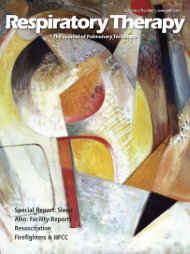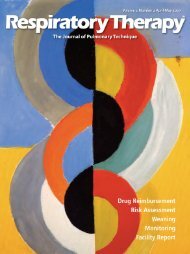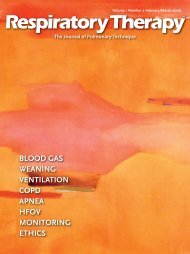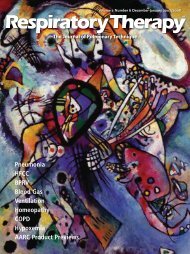RT 02-03 JJ07 main web - Respiratory Therapy Website
RT 02-03 JJ07 main web - Respiratory Therapy Website
RT 02-03 JJ07 main web - Respiratory Therapy Website
Create successful ePaper yourself
Turn your PDF publications into a flip-book with our unique Google optimized e-Paper software.
Profile Critical Care Xpress offers a comprehensive 20-test<br />
critical care profile including blood gases, electrolytes,<br />
chemistry, hematology, and co-oximetry. Nova is among the few<br />
critical care companies to offer serum creatinine as part of its<br />
analyzer test profile and is the only critical care company to<br />
provide the eGFR calculation. Version 5 software enables Stat<br />
Profile Critical Care Xpress analyzers to be configured for all of<br />
the currently accepted eGFR equations, including Cockcroft-<br />
Gault, MDRD, and IDMS-Traceable calculations for adults, and<br />
Schwartz and Counahan-Barrett calculations for children.<br />
Contact novabio.com.<br />
ADAPTIVE<br />
Respironics, Inc announced that it has formed an agreement<br />
with The State University of New York (SUNY) and New York<br />
University School of Medicine (NYU) to utilize the I-neb<br />
Adaptive Aerosol Delivery (AAD) System for clinical evaluation<br />
of aerosolized Interferon Gamma for the treatment of Idiopathic<br />
Pulmonary Fibrosis (IPF). The clinical trial will take place over<br />
a two-year time period. The I-neb device uses Respironics’ AAD<br />
technology which is an intelligent inhalation technology that<br />
continually monitors and automatically adapts to an individual<br />
patient’s breathing pattern to deliver a precise medication dose<br />
during the patient’s inhalation phase. The result is precise,<br />
reproducible dosing of medication to each patient, regardless of<br />
his/her breathing pattern. Precise dosing is important in<br />
ensuring that patients receive a safe and therapeutic dose of<br />
medication. The I-neb AAD System is Respironics’ third<br />
generation AAD System and is smaller, quieter and more<br />
portable than earlier product generations. The device weighs<br />
less than eight ounces and can be carried discreetly in a purse,<br />
pocket or briefcase. The I-neb device also provides audible and<br />
visual feedback to the patient informing the patient when the<br />
treatment is complete.<br />
NEWS FEATURES<br />
AARC SYMPOSIUM:<br />
LAS VEGAS, 2007 - HELONTIX<br />
Helium/Oxygen Mixtures<br />
in Children: Bronchiolitis<br />
and Other <strong>Respiratory</strong><br />
Obstruction<br />
Federico Martinón-Torres, MD, PhD<br />
The author is with Hospital Clínico Universitario de Santiago, Spain. The<br />
following was presented at AARC 2007, at the Helontix Symposium.<br />
Despite the apparently conflicting clinical evidence regarding<br />
it’s utility, heliox has gained widespread support and use in<br />
many pediatric emergency departments and intensive care units.<br />
Several potential indications have been suggested for heliox<br />
therapy, with particularly outstanding beneficial effects for<br />
patients with asthma, bronchiolitis, and upper respiratory<br />
obstructions with various etiologies.<br />
Helium is a biologically inert gas of low molecular weight,<br />
which, when blended with oxygen, results in a gas mixture<br />
(heliox) with a markedly lower density than air (specifically,<br />
heliox with 21% oxygen has one third the density of air). Its<br />
application in the setting of obstructive airway disease will<br />
decrease airway resistance to flow, and thus reduce the work of<br />
breathing. Heliox has also been shown to enhance alveolar<br />
ventilation due to its high diffusion coefficient, which may<br />
improve carbon dioxide removal. Heliox has no inherent<br />
therapeutic effect, and thus can be used only as a temporising<br />
agent - it provides time until definitive therapies act or the<br />
subjacent pathologic circumstance spontaneously resolves. The<br />
inert nature of heliox explains the extreme rarity of secondary<br />
effects and the negligible risk of its clinical use. Interestingly,<br />
any beneficial effect of heliox should become evident in a<br />
relatively short period of time, one hour usually being sufficient.<br />
We have extensively evaluated the therapeutic safety and<br />
efficacy of non-invasive administration of heliox, to infants with<br />
acute moderate to severe bronchiolitis: first as an initial elective<br />
treatment administered via a non-rebreathing mask with<br />
reservoir in patient spontaneously breathing; or secondly as a<br />
rescue treatment for patients refractory to the standard<br />
treatment, administered noninvasively in combination with<br />
positive pressure, via a system adapted for the use of nasal<br />
continuous positive pressure with heliox. In our experience, the<br />
elective treatment with heliox administered non-invasively to<br />
infants with acute moderate to severe bronchiolitis, via a nonrebreathing<br />
reservoir mask, improves respiratory conditions in a<br />
simple, innocuous, safe and non-invasive way. This was<br />
demonstrated by the noticeable improvement of the clinical<br />
scores, the decrease of the concomitant tachycardia and<br />
tachypnoea and the reduction in the length of stay (











